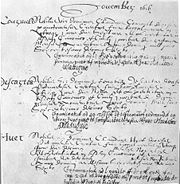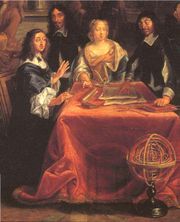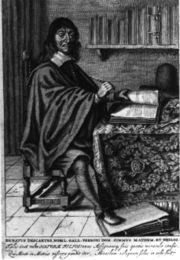René Descartes
2008/9 Schools Wikipedia Selection. Related subjects: Philosophers
| Western Philosophy 17th-century philosophy |
|
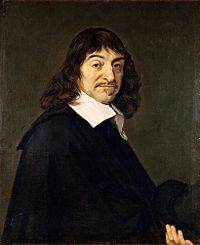 René Descartes. Portrait by Frans Hals, 1648. |
|
| Full name | René Descartes |
|---|---|
| Birth | March 31, 1596 La Haye en Touraine [now Descartes], Indre-et-Loire, France |
| Death | February 11, 1650 (aged 53) Stockholm, Sweden |
| School/tradition | Cartesianism, Rationalism, Foundationalism |
| Main interests | Metaphysics, Epistemology, Science, Mathematics |
| Notable ideas | Cogito ergo sum, method of doubt, Cartesian coordinate system, Cartesian dualism, ontological argument for existence of God; regarded as a founder of Modern philosophy |
|
Influenced by
|
|
|
Influenced
|
|
René Descartes (French IPA: [ʁəne de'kaʁt]), ( March 31, 1596 – February 11, 1650), also known as Renatus Cartesius ( latinized form), was a highly influential French philosopher, mathematician, scientist, and writer. He has been dubbed the "Father of Modern Philosophy," and much of subsequent Western philosophy is a response to his writings, which continue to be studied closely. His influence in mathematics is also apparent, the Cartesian coordinate system that is used in plane geometry and algebra being named for him, and he was one of the key figures in the Scientific Revolution.
Descartes frequently sets his views apart from those of his predecessors. In the opening section of the Passions of the Soul, a treatise on the Early Modern version of what are now commonly called emotions, he goes so far as to assert that he will write on his topic "as if no one had written on these matters before". Many elements of his philosophy have precedents in late Aristotelianism, the revived Stoicism of the 16th century, or in earlier philosophers like St. Augustine. In his natural philosophy, he differs from the Schools on two major points: First, he rejects the analysis of corporeal substance into matter and form; second, he rejects any appeal to ends — divine or natural — in explaining natural phenomena. In his theology, he insists on the absolute freedom of God’s act of creation.
Descartes was a major figure in 17th century continental rationalism, later advocated by Baruch Spinoza and Gottfried Leibniz, and opposed by the empiricist school of thought consisting of Hobbes, Locke, Berkeley, and Hume. Leibniz, Spinoza and Descartes were all versed in mathematics as well as philosophy, and Descartes and Leibniz contributed greatly to science as well. As the inventor of the Cartesian coordinate system, Descartes founded analytic geometry, the bridge between algebra and geometry, crucial to the invention of calculus and analysis. Descartes' reflections on mind and mechanism began the strain of Western thought that much later, impelled by the invention of the electronic computer and by the possibility of machine intelligence, blossomed into the Turing test and related thought. His most famous statement is: Cogito ergo sum (French: Je pense, donc je suis; English: I think, therefore I am; or better, I am thinking, therefore I exist), found in §7 of part I of Principles of Philosophy (Latin) and in part IV of Discourse on the Method (French).
Biography
Descartes was born in La Haye en Touraine (now Descartes), Indre-et-Loire, France. When he was one year old, his mother Jeanne Brochard died of tuberculosis. His father Joachim was a judge in the High Court of Justice. At the age of eleven, he entered the Jesuit Collège Royal Henry-Le-Grand at La Flèche. After graduation, he studied at the University of Poitiers, earning a Baccalauréat and License in law in 1616, in accordance with his father's wishes that he should become a lawyer.
| “ | I entirely abandoned the study of letters. Resolving to seek no knowledge other than that of which could be found in myself or else in the great book of the world, I spent the rest of my youth travelling, visiting courts and armies, mixing with people of diverse temperaments and ranks, gathering various experiences, testing myself in the situations which fortune offered me, and at all times reflecting upon whatever came my way so as to derive some profit from it. (Descartes, Discourse on the Method) | ” |
On November 10, 1618, while walking through Breda, Descartes met Isaac Beeckman, who sparked his interest in mathematics and the new physics, particularly the problem of the fall of heavy bodies.
In 1622 he returned to France, and during the next few years spent time in Paris and other parts of Europe. He arrived in La Haye in 1623, selling all of his property, investing this remuneration in bonds which provided Descartes with a comfortable income for the rest of his life. Descartes was present at the siege of La Rochelle by Cardinal Richelieu in 1627.
He returned to the Dutch Republic in 1628, where he lived until September 1649. In April 1629 he joined the University of Franeker and the next year Leiden University. In October 1630 he had a falling out with Beeckman, whom he accused of plagiarizing some of his ideas (though the situation was more likely the reverse). In Amsterdam, he had a relationship with a servant girl, Helène Jans, with whom he had a daughter, Francine, who was born in 1635 in Deventer, at which time Descartes taught at the Utrecht University. Francine Descartes died in 1640 in Amersfoort.
While in the Netherlands he changed his address frequently, living among other places in Dordrecht (1628), Franeker (1629), Amsterdam (1629-30), Leiden (1630), Amsterdam (1630-2), Deventer (1632-4), Amsterdam (1634-5), Utrecht (1635-6), Leiden (1636), Egmond (1636-8), Santpoort (1638–1640), Leiden (1640-1), Endegeest (a castle near Oegstgeest) (1641-3), and finally for an extended time in Egmond-Binnen (1643-9).
Despite these frequent moves he wrote all his major work during his 20 plus years in the Netherlands, where he managed to revolutionize mathematics and philosophy. In 1633, Galileo was condemned by the Roman Catholic Church, and Descartes abandoned plans to publish Treatise on the World, his work of the previous four years. "Discourse on the Method" was published in 1637. In it an early attempt at explaining reflexes mechanistically is made. Descartes also lays out four rules of thought, meant to ensure that our knowledge rests upon a firm foundation.
Descartes continued to publish works concerning both mathematics and philosophy for the rest of his life. In 1643, Cartesian philosophy was condemned at the University of Utrecht, and Descartes began his long correspondence with Princess Elizabeth of Bohemia. In 1647, he was awarded a pension by the King of France. Descartes was interviewed by Frans Burman at Egmond-Binnen in 1648.
René Descartes died on February 11, 1650 in Stockholm, Sweden, where he had been invited as a teacher for Queen Christina of Sweden. The cause of death was said to be pneumonia — accustomed to working in bed until noon, he may have suffered a detrimental effect on his health due to Christina's demands for early morning study (the lack of sleep could have severely compromised his immune system). Others believe that Descartes may have contracted pneumonia as result of nursing a French ambassador, Dejion A. Nopeleen, ill with the aforementioned disease, back to health.
In 1663, the Pope placed his works on the Index of Prohibited Books.
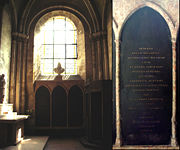
As a Roman Catholic in a Protestant nation, he was interred in a graveyard mainly used for unbaptized infants in Adolf Fredrikskyrkan in Stockholm. Later, his remains were taken to France and buried in the church of Sainte-Geneviève-du-Mont in Paris. His memorial erected in the 18th century remains in the Swedish church.
During the French Revolution, his remains were disinterred for burial in the Panthéon among the great French thinkers. The village in the Loire Valley where he was born was renamed La Haye - Descartes in 1802, which was shortened to "Descartes" in 1967. Currently his tomb is in the church of Saint-Germain-des-Prés in Paris; his brain, however, resides in the Musée de l'Homme.
Philosophical work
Descartes is often regarded as the first modern thinker to provide a philosophical framework for the natural sciences as these began to develop. In his Discourse on the Method he attempts to arrive at a fundamental set of principles that one can know as true without any doubt. To achieve this, he employs a method called hyperbolical/metaphysical doubt, sometimes also referred to as methodological skepticism: he rejects any ideas that can be doubted, and then reestablishes them in order to acquire a firm foundation for genuine knowledge.
Initially, Descartes arrives at only a single principle: thought exists. Thought cannot be separated from me, therefore, I exist (Discourse on the Method and Principles of Philosophy). Most famously, this is known as cogito ergo sum (Latin: "I think, therefore I am"), or more precisely, " Dubito, ergo cogito, ergo sum" (Latin: "I doubt, therefore I think, therefore I am"). Therefore, Descartes concluded, if he doubted, then something or someone must be doing the doubting, therefore the very fact that he doubted proved his existence. "The simple meaning of the phrase is that if someone is wondering whether or not he exists, that is in and of itself proof that he does exist."
Descartes concludes that he can be certain that he exists because he thinks. But in what form? He perceives his body through the use of the senses; however, these have previously been proven unreliable. So Descartes concludes that the only indubitable knowledge is that he is a thinking thing. Thinking is his essence as it is the only thing about him that cannot be doubted. Descartes defines "thought" (cogitatio) as "what happens in me such that I am immediately conscious of it, insofar as I am conscious of it". Thinking is thus every activity of a person of which he is immediately conscious.
To further demonstrate the limitations of the senses, Descartes proceeds with what is known as the Wax Argument. He considers a piece of wax; his senses inform him that it has certain characteristics, such as shape, texture, size, colour, smell, and so forth. When he brings the wax towards a flame, these characteristics change completely. However, it seems that it is still the same thing: it is still a piece of wax, even though the data of the senses inform him that all of its characteristics are different. Therefore, in order to properly grasp the nature of the wax, he cannot use the senses. He must use his mind. Descartes concludes:
| “ | Thus what I thought I had seen with my eyes, I actually grasped solely with the faculty of judgment, which is in my mind. | ” |
In this manner, Descartes proceeds to construct a system of knowledge, discarding perception as unreliable and instead admitting only deduction as a method. In the third and fifth Meditation, he offers an ontological proof of a benevolent God (through both the ontological argument and trademark argument). Because God is benevolent, he can have some faith in the account of reality his senses provide him, for God has provided him with a working mind and sensory system and does not desire to deceive him. From this supposition, however, he finally establishes the possibility of acquiring knowledge about the world based on deduction and perception. In terms of epistemology therefore, he can be said to have contributed such ideas as a rigorous conception of foundationalism and the possibility that reason is the only reliable method of attaining knowledge.
In Descartes' system, knowledge takes the form of ideas, and philosophical investigation is the contemplation of these ideas. This concept would influence subsequent internalist movements as Descartes' epistemology requires that a connection made by conscious awareness will distinguish knowledge from falsity. As a result of his Cartesian doubt, he viewed rational knowledge as being "incapable of being destroyed" and sought to construct an unshakable ground upon which all other knowledge can be based. The first item of unshakable knowledge that Descartes argues for is the aforementioned cogito, or thinking thing.
Descartes also wrote a response to skepticism about the existence of the external world. He argues that sensory perceptions come to him involuntarily, and are not willed by him. They are external to his senses, and according to Descartes, this is evidence of the existence of something outside of his mind, and thus, an external world. Descartes goes on to show that the things in the external world are material by arguing that God would not deceive him as to the ideas that are being transmitted, and that God has given him the "propensity" to believe that such ideas are caused by material things.
Descartes was also renowned for his work in producing the Cartesian Theory of Fallacies. This can be most easily explored using the statement: "This statement is a lie." While it is most commonly referred to as a paradox, the Cartesian Theory of Fallacies states that at any given time a statement can be both true and false simultaneously due to its contradictory nature. The statement is true in its fallacy. Thus, Descartes developed the Cartesian Theory of Fallacies, which greatly influenced the thinking of the time. Many would-be philosophers were trying to develop inexplicable statements of seeming fact, however, this laid rumors of such a proposition impossible. Many philosophers believe that when Descartes formulated his Theory of Fallacies, he intended to be lying, which in and of itself embodies the theory.
Dualism
Descartes suggested that the body works like a machine, that it has the material properties of extension and motion, and that it follows the laws of physics. The mind (or soul), on the other hand, was described as a nonmaterial entity that lacks extension and motion, and does not follow the laws of physics. Descartes argued that only humans have minds, and that the mind interacts with the body at the pineal gland. This form of dualism proposes that the mind controls the body, but that the body can also influence the otherwise rational mind, such as when people act out of passion. Most of the previous accounts of the relationship between mind and body had been uni-directional.
Descartes suggested that the pineal gland is "the seat of the soul" for several reasons. First, the soul is unitary, and unlike many areas of the brain the pineal gland appears to be unitary (microscopic inspection reveals it is formed of two hemispheres). Second, Descartes observed that the pineal gland was located near the ventricles. He believed the animal spirits of the ventricles acted through the nerves to control the body, and that the pineal gland influenced this process. Finally, Descartes incorrectly believed that only humans have pineal glands, just as, in his view, only humans have minds. This led him to the belief that animals cannot feel pain, and Descartes' practice of vivisection (the dissection of live animals) became widely used throughout Europe until the Enlightenment. Cartesian Dualism set the agenda for philosophical discussion of the mind-body problem for many years after Descartes' death. The question of how a nonmaterial mind could influence a material body, without invoking supernatural explanations, remains an enigma to this day.
Mathematical legacy
Amazingly, Descartes' theory provided the basis for the calculus of Newton and Leibniz, by applying infinitesimal calculus to the tangent line problem, thus permitting the evolution of that branch of modern mathematics. This appears even more astounding considering that the work was just intended as an example to his Discours de la méthode pour bien conduire sa raison, et chercher la verité dans les sciences (Discourse on the Method to Rightly Conduct the Reason and Search for the Truth in Sciences, better known under the shortened title Discours de la méthode).
Descartes' rule of signs is also a commonly used method to determine the number of positive and negative zeros of a polynomial.
Descartes created analytic geometry, and discovered an early form of the law of conservation of momentum. He outlined his views on the universe in his Principles of Philosophy.
Descartes also made contributions to the field of optics. He showed by using geometric construction and the law of refraction (also known as Descartes' law) that the angular radius of a rainbow is 42 degrees (i.e. the angle subtended at the eye by the edge of the rainbow and the ray passing from the sun through the rainbow's centre is 42°). He also independently discovered the law of reflection, and his essay on optics was the first published mention of this law.
One of Descartes most enduring legacies was his development of Cartesian geometry which uses algebra to describe geometry. He also invented the notation which uses superscripts to show the powers or exponents, for example the 2 used in x² to indicate squaring.
Writings by Descartes
- 1618. Compendium Musicae. A treatise on music theory and the aesthetics of music written for Descartes' early collaborator Isaac Beeckman.
- 1626–1628. Regulae ad directionem ingenii ( Rules for the Direction of the Mind). Incomplete. First published posthumously in 1684. The best critical edition, which includes an early Dutch translation, is edited by Giovanni Crapulli (The Hague: Martinus Nijhoff, 1966).
- 1630–1633. Le Monde ( The World) and L'Homme (Man). Descartes' first systematic presentation of his natural philosophy. Man was first published in Latin translation in 1662; The World in 1664.
- 1637. Discours de la méthode ( Discourse on the Method). An introduction to the Essais, which include the Dioptrique, the Météores and the Géométrie.
- 1637. La Géométrie (Geometry). Descartes' major work in mathematics. There is an English translation by Michael Mahoney (New York: Dover, 1979).
- 1641. Meditationes de prima philosophia ( Meditations on First Philosophy), also known as Metaphysical Meditations. In Latin; a French translation, probably done without Descartes' supervision, was published in 1647. Includes six Objections and Replies. A second edition, published the following year, included an additional objection and reply, and a Letter to Dinet.
- 1644. Principia philosophiae ( Principles of Philosophy), a Latin textbook at first intended by Descartes to replace the Aristotelian textbooks then used in universities. A French translation, Principes de philosophie by Claude Picot, under the supervision of Descartes, appeared in 1647 with a letter-preface to Queen Christina of Sweden.
- 1647. Notae in programma (Comments on a Certain Broadsheet). A reply to Descartes' one-time disciple Henricus Regius.
- 1647. The Description of the Human Body. Published posthumously.
- 1648. Responsiones Renati Des Cartes… (Conversation with Burman). Notes on a Q&A session between Descartes and Frans Burman on 16 April 1648. Rediscovered in 1895 and published for the first time in 1896. An annotated bilingual edition (Latin with French translation), edited by Jean-Marie Beyssade, was published in 1981 (Paris: PUF).
- 1649. Les passions de l'âme ( Passions of the Soul). Dedicated to Princess Elizabeth of Bohemia.
- 1657. Correspondence. Published by Descartes' literary executor Claude Clerselier. The third edition, in 1667, was the most complete; Clerselier omitted, however, much of the material pertaining to mathematics.
